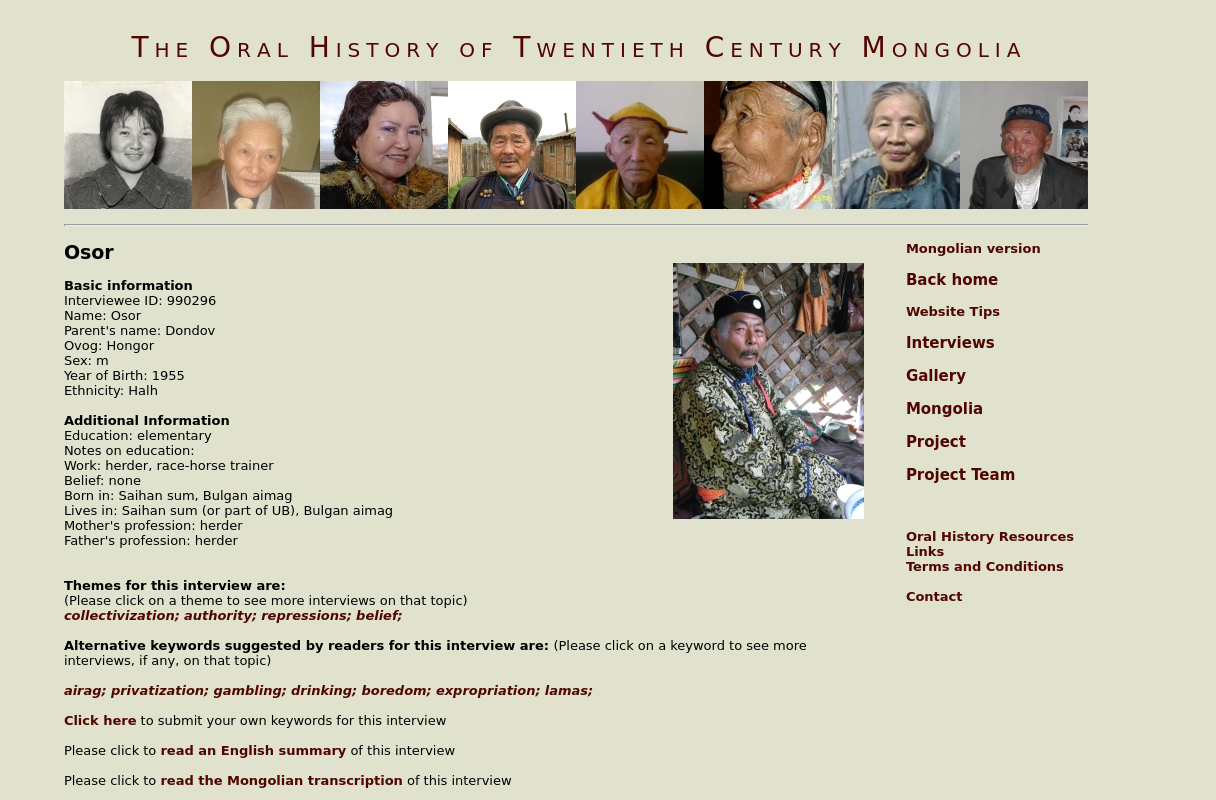Oral history interview No. 090744A with Osor (b. 1955): translation
Metadata
collection
The Oral History of Twentieth Century Mongolia
identifier
770ffc3a-aa1e-4812-a82a-a3f81a1fc276
creator
type
coverage
description
A former cooperative horse herder. Now he is a race horse trainer, herder. Many relatives and children of Lamjav guai (see interview 090102; interviewee 990080) have given interviews in our project and one of them is D. Osor. The interviews of the many family relatives of Lamjav guai is an interesting aspect of the 20th century Mongolian oral history study. It is very interesting to trace by one family’s developmental history the oral Mongolian history of the socialist period, its end, and the democratic period. D.Osor is the youngest brother of Lamjav. He was born in 1955 in Saihan sum of Bulgan aimag. In 1973-1976 he served in the military and after demobilization he came back to the collective and tended the horses for twelve years. His childhood was just the same as the other countryside herders’ children of that time. Tending the collective livestock was harsh work and he compared it with tending prison livestock. He recalled fulfilling the planning norms and other pressures they had and that it was very tough. He talked extensively about the ways of tending the livestock at that time, how the herders raised their children and the relations between the dargas and their subordinates. After being demobilized he used to tend over 500 of the collective’s horses and later he also tended horses. In fact, all his life he has been tending horses. At the time of 1990 democratic storm he found the books written by Baabar and other newspapers that were distributed among the people and he read them. He read it to the people and talked about the nice thing called democracy. That’s why people of that time gave him the name of ‘Bürd’s Zorig’. With the break-up of the collective they also quit the collective together with the first 13 ails. He said he considered it a blessing of democracy that he has raised the livestock to their current level and is living a sufficient life. He talked a little about the process of privatization. He compared the herders’ method of tending the livestock and their work attitude in the socialist time with the present day work attitude of the people and he criticized the current one. He told a detailed story of the Chinese airag china bowl he had. It was the possession of Chin van Handdorj of Halh province, the noyon of our province. He also told a story of a snuff bottle called ‘usan siizen’. It was his brother’s snuffbox that was brought by a famous lama, a skilled craftsman named Shijiree from the Halh Bogd monastery, Bogd Sats around the beginning of the nineteenth century.
publisher
Oral History of Twentieth Century Mongolia
source
rights
Copyright MIASU. Reproduced with permission. Brief excerpts from interviews and other material may be used in academic or popular work for non-commercial purposes provided proper attribution and credit is given to the Oral History of Twentieth Century Mongolia and the Mongolia and Inner Asia Studies Unit (MIASU). You must not: (a) republish this material (including republication on another website) without the express written permission of MIASU; (b) sell, rent or sub-license material from the website; (c) show any material from the website in public without attribution to The Oral History of Twentieth Century Mongolia; (d) reproduce, duplicate, copy or otherwise exploit material on the website for a commercial purpose without express written permission; (e) use the material in any way that is damaging to the project or any of the persons named in the interviews. See http://amantuuh.socanth.cam.ac.uk/terms.php for details.
subject
date
2009
language
files
| df-pdf | 226.7 KiB | 2017-05-29 12:11:12 | |
| df-screenshot | png | 112.1 MiB | 2017-05-29 12:11:12 |
| metadata-en | docx | 542.9 KiB | 2018-01-08 14:57:25 |
